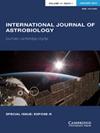冯?诺依曼探索者的前景及其对萨甘?多路复用器争论的启示
IF 1
4区 物理与天体物理
Q3 ASTRONOMY & ASTROPHYSICS
引用次数: 0
摘要
20世纪80年代初,卡尔·萨根和弗兰克·蒂普勒在《皇家天文学会季刊》上发表了一系列关于ETI的文章,这在当时引起了轰动。20世纪90年代初,在苏塞克斯大学攻读天文学硕士学位时,我向约翰·巴罗教授表达了我对SETI的兴趣,他向我介绍了他与弗兰克·蒂普勒合著的《人类宇宙学原理》一书中的相关章节(我仍然推荐整本书的远见卓识)。我立即找到了原始材料,并被正在讨论的冯·诺依曼或自复制探针概念所打动(我将使用后一个术语来避免与冯·诺伊曼机器混淆,后者在计算机工程中有着公认的含义)。这是我通往大马士革的道路,使我从ETI信徒转变为怀疑论者(但靠的是科学论证的力量,而不是任何顿悟)。从那时起,我决定攻读太空工程博士学位,专门研究太空机器人(尽管我的研究项目比自我复制探测器更平凡)。然而,尽管萨根-提普勒的辩论具有基础性的重要性,但今天它几乎被遗忘了,尽管它暴露了SETI冒险的根源和分支。然而,偶尔仍会有关于自我复制探测器的论文,但它们似乎是SETI计划的次要内容。这期特刊试图将自我复制的探测器重新聚焦到SETI的主流中。这期特刊有四篇论文。Dobler(2022)的论文为费米悖论提供了理想的上下文讨论,即现存的ETI现在不在这里。他建议,任何乐观的解释都必须接受这样一个事实,即接触的可能性一定很低,这种情况将继续下去。他认为,尽管没有一种解释可以解释费米悖论,但也许一套适用于不同类别ETI的解释足以涵盖这个问题的普遍性。这让人想起应对气候变化的“楔形”方法(Pacala&Solow,2004年)。它确实要求解释性楔子,即使它们由于动态因素而随着时间的推移而改变权重,也必须保持其非接触性的普遍覆盖范围。然而,从工具的角度来看,这与Dobler(2022)指出的ETI不存在的断言并不不同。只有稳定的因素,如星际旅行的不可置信性,才足以在持续缺乏证据的情况下解释ETI的存在。这与Matloff(2022)的论文非常吻合,该论文讨论了与自复制探测器相关的问题,包括星际飞行的推进。他分析了几个技术日益成熟的可行方案。重力辅助的使用,无论是无动力的还是有动力的,都是公认的,但这种方法会产生超长的星际传输时间~10-10年/年。在下个世纪,这种探测器几乎肯定会被更先进的探测器所取代。各种形式的核推进被认为可以提高性能,并将飞行时间减少到~1000年/年。无推进剂帆也被认为具有类似的性能。本文章由计算机程序翻译,如有差异,请以英文原文为准。
The prospect of von neumann probes and the implications for the sagan-tipler debate
In the early 1980s, Carl Sagan and Frank Tipler published a series of articles in the pages of the Quarterly Journal of the Royal Astronomical Society on ETI that became a cause celebre at the time. Whilst reading for an MSc in Astronomy at the University of Sussex in the early 1990s, I expressed my interest in SETI as a staunch Saganite (influenced not only by the phenomenal Cosmos TV series, recently re-vamped by Neil de Grasse Tyson, but also by Sagan’s preceding Royal Institution Christmas lecture series) to Professor John Barrow who introduced me to the relevant chapter in the book The Anthropic Cosmological Principle that he co-authored with Frank Tipler (I still recommend the entire book for its visionary scope). I immediately went to source material and was struck by the von Neumann or self-replicating probe concept under discussion (I shall use the latter term to avoid conflation with von Neumann machine which has a well-established meaning in computer engineering). This was my road to Damascus in converting me from ETI believer to skeptic (but by the power of scientific argument rather than any epiphany). Thence, I decided to pursue a PhD in space engineering specialising in space robotics (though my research project was rather more mundane than self-replicating probes). Yet, despite its foundational importance, the Sagan-Tipler debate is almost forgotten today despite the fact that it exposes the root-and-branch of the SETI venture. However, every now and then, there is still the occasional paper on self-replicating probes but they appear to be sidestream to the SETI programme. This special issue seeks to re-focus the self-replicating probe back into the SETI mainstream where it belongs. There are four papers in this special issue. Dobler’s (2022) paper provides the ideal contextual discussion of the Fermi paradox that extant ETI are not here now. He suggests that any optimistic interpretation must accept that there must be a low probability of contact and that this state of affairs shall continue. He suggests that, although no one explanation can account for the Fermi paradox, perhaps a suite of explanations applicable to different categories of ETI are sufficient to cover the universality of the problem. And this will remain so. This is reminiscent of the “wedges” approach to combatting climate change (Pacala & Solow 2004). It does require that the explanatory wedges, even if they shift their weightings over time due to dynamic factors, must retain their universal coverage of non-contact. Nevertheless, from an instrumental viewpoint, this differs not from the assertion that ETI do not exist as Dobler (2022) points out. Only stable factors such as implausibility of interstellar travel are universal enough to account for the existence of ETI with the persistent lack of evidence. This dovetails neatly into Matloff’s (2022) paper who addresses issues associated with the selfreplicating probes including propulsion for interstellar flight. He analyses several plausible options of increasingly technological sophistication. The use of gravity assists, be they unpowered or powered, is well-established but such methods yield extremely long interstellar transmit times ∼10-10 y/ly. Such probes would almost certainly be overtaken by more advanced probes within the next century. Various forms of nuclear propulsion were considered to improve performance and reduce flight times to ∼1000 y/ly. Propellantless sails were also considered to offer similar performance.
求助全文
通过发布文献求助,成功后即可免费获取论文全文。
去求助
来源期刊

International Journal of Astrobiology
地学天文-地球科学综合
CiteScore
3.70
自引率
11.80%
发文量
45
审稿时长
>12 weeks
期刊介绍:
International Journal of Astrobiology is the peer-reviewed forum for practitioners in this exciting interdisciplinary field. Coverage includes cosmic prebiotic chemistry, planetary evolution, the search for planetary systems and habitable zones, extremophile biology and experimental simulation of extraterrestrial environments, Mars as an abode of life, life detection in our solar system and beyond, the search for extraterrestrial intelligence, the history of the science of astrobiology, as well as societal and educational aspects of astrobiology. Occasionally an issue of the journal is devoted to the keynote plenary research papers from an international meeting. A notable feature of the journal is the global distribution of its authors.
 求助内容:
求助内容: 应助结果提醒方式:
应助结果提醒方式:


